Indoors Locality Positioning Using Cognitive Distances and Directions
Abstract
:1. Introduction
2. Related Work
2.1. Distance Relationship
2.2. Direction Relationship
3. Fuzzy Distance and Relative Direction Function
3.1. Cognitive Experiment and Fuzzy Distance Function
3.2. Fuzzy Relative Direction Function
4. Positioning Localities Based on Probability Function
4.1. Location Region: Admissible Domain
4.2. Probability Distribution: Joint Probability Function
- (1)
- We obtain Visible_Seg(A) and Visible_Seg(B) from locality t with upper fuzzy distance t ∈ Admiss_Dom(A,B).
- (2)
- Refinement is performed to calculate distance probability Pdis(t) with two ROs. PdisA(t) is the membership degree that maps the average dis(a,t) via the distance membership function Equation (1), that is, a ∈ Visible_Seg(A):
- (3)
- We calculate direction probability Pdir(t). PABdir(t) is the membership degree that maps the average dir(a,t,b) via the relative direction membership function Equation (2), that is, a ∈ Visible_Seg(A) and b ∈ Visible_Seg(B):
- (4)
- Refinement is performed to calculate joint probability P(t):
- (1)
- We obtain Visible_Seg(A), Visible_Seg(B), and Visible_Seg(C) from locality t with upper fuzzy distance t ∈ Admiss_Dom(A,B,C).
- (2)
- We calculate distance probability Pdis(t) with Equation (1):
- (3)
- We calculate direction probability Pdir(t) with Equation (2):
- (4)
- Joint probability P(t) is obtained with Equation (6):
5. Case Study
6. Conclusions and Future Work
- (1)
- The intersection of the rings around ROs is modeled to the region (i.e., admissible domain) for location description. Two regions are commonly found in two ROs; the unique region can be selected.
- (2)
- A cognitive experiment based on distance is conducted to obtain the width of rings, and a distance membership function is constructed to describe how far a locality is from the RO.
- (3)
- To access the degree-to-direction relationship of a locality relative to ROs, we develop a novel relative direction membership function that is consistent with human spatial intuition.
- (4)
- A joint probability function based on distance and relative direction membership functions is provided to determine the position degree. For consistency with intuition, we provide the notion of visible segment and its restrictions.
Acknowledgments
Author Contributions
Conflicts of Interest
References
- Krishnapuram, R.; Keller, J.M.; Ma, Y. Quantitative analysis of properties and spatial relations of fuzzy image regions. IEEE Trans. Fuzzy Syst. 1993, 1, 222–233. [Google Scholar] [CrossRef]
- Bloch, I.; Ralescu, A. Directional relative position between objects in image processing: A comparison between fuzzy approaches. Pattern Recognit. 2003, 36, 1563–1582. [Google Scholar] [CrossRef]
- Christodoulou, G.; Petrakis, E.G.M.; Batsakis, S. Qualitative spatial reasoning using topological and directional information in OWL. In Proceedings of the IEEE 2012 24th International Conference on Tools with Artificial Intelligence, Athens, Greece, 7–9 November 2012; pp. 596–602. [Google Scholar]
- Cohn, A.G. Qualitative spatial representation and reasoning techniques. In Proceedings of the 21st Annual German Conference on Artificial Intelligence, Freiburg, Germany, 9–12 September 1997; Springer: Berlin/Heidelberg, Germany, 1997; pp. 1–30. [Google Scholar]
- Liu, Y.; Guo, Q.H.; Wieczorek, J.; Goodchild, M.F. Positioning localities based on spatial assertions. Int. J. Geogr. Inf. Sci. 2009, 23, 1471–1501. [Google Scholar] [CrossRef]
- Yao, X.; Thill, J.C. Spatial queries with qualitative locations in spatial information systems. Comput. Environ. Urban Syst. 2006, 30, 485–502. [Google Scholar] [CrossRef]
- Bennett, B.; Agarwal, P. Semantic categories underlying the meaning of ‘place’. In Proceedings of the International Conference on Spatial Information Theory, Melbourne, Australia, 19–23 September 2007; Springer: Berlin/Heidelberg, Germany, 2007; pp. 78–95. [Google Scholar]
- Jiang, B.; Yao, X. Location-based services and GIS in perspective. Comput. Environ. Urban Syst. 2006, 30, 712–725. [Google Scholar] [CrossRef]
- Wieczorek, J.; Guo, Q.; Hijmans, R. The point-radius method for georeferencing locality descriptions and calculating associated uncertainty. Int. J. Geogr. Inf. Sci. 2004, 18, 745–767. [Google Scholar] [CrossRef]
- Guo, Q.; Liu, Y.; Wieczorek, J. Georeferencing locality descriptions and computing associated uncertainty using a probabilistic approach. Int. J. Geogr. Inf. Sci. 2008, 22, 1067–1090. [Google Scholar] [CrossRef]
- Deng, M.; Li, Z. A statistical model for directional relations between spatial objects. Geoinformatica 2008, 12, 193–217. [Google Scholar] [CrossRef]
- Matsakis, P.; Wendling, L. A new way to represent the relative position between areal objects. IEEE Trans. Pattern Anal. 1999, 21, 634–643. [Google Scholar] [CrossRef]
- Bloch, I.; Colliot, O.; Cesar, R.M. On the ternary spatial relation “between”. IEEE Trans. Syst. Man Cybern. Part B 2006, 36, 312–327. [Google Scholar] [CrossRef]
- Worboys, M.F. Nearness relations in environmental space. Int. J. Geogr. Inf. Sci. 2001, 15, 633–651. [Google Scholar] [CrossRef]
- Yao, X.; Thill, J.C. How Far Is Too Far?—A Statistical Approach to Context-contingent Proximity Modeling. Trans. GIS 2005, 9, 157–178. [Google Scholar] [CrossRef]
- Andrew, U.F.; Mark, D.; White, D. Qualitative spatial reasoning about cardinal directions. In Proceedings of the 7th Austrian Conference on Artificial Intelligence, Wien, Austria, 24–27 September 1991; Morgan Kaufmann: Baltimore, MD, USA, 1991; pp. 157–167. [Google Scholar]
- Goyal, R.K.; Egenhofer, M.J. Similarity of cardinal directions. In Proceedings of the International Symposium on Spatial and Temporal Databases, Redondo Beach, CA, USA, 12–15 July 2001; Springer: Berlin/Heidelberg, Germany, 2001; pp. 36–55. [Google Scholar]
- Liu, Y.; Wang, X.; Jin, X.; Wu, L. On internal cardinal direction relations. In Proceedings of the International Conference on Spatial Information Theory, Ellicottville, NY, USA, 19–23 September 2005; Springer: Berlin/Heidelberg, Germany, 2005; pp. 283–299. [Google Scholar]
- Hudelot, C.; Atif, J.; Bloch, I. Fuzzy spatial relation ontology for image interpretation. Fuzzy Sets Syst. 2008, 159, 1929–1951. [Google Scholar] [CrossRef]
- Guadarrama, S.; Riano, L.; Golland, D.; Gouhring, D.; Jia, Y.; Klein, D.; Abbeel, P.; Darrell, T. Grounding spatial relations for human-robot interaction. In Proceedings of the International Conference on Intelligent Robots and Systems, Tokyo, Japan, 3–7 November 2013; pp. 1640–1647. [Google Scholar]
- Vanegas, M.C.; Bloch, I.; Inglada, J. A fuzzy definition of the spatial relation “surround”-Application to complex shapes. In Proceedings of the 7th Conference of the European Society for Fuzzy Logic and Technology, Amsterdam, Holland, 22 July 2011; pp. 844–851. [Google Scholar]
- Takemura, C.M.; Cesar, R.M.; Bloch, I. Modeling and measuring the spatial relation “along”: Regions, contours and fuzzy sets. Pattern Recognit. 2012, 45, 757–766. [Google Scholar] [CrossRef]
- Schockaert, S.; De Cock, M.; Kerre, E.E. Location approximation for local search services using natural language hints. Int. J. Geogr. Inf. Sci. 2008, 22, 315–336. [Google Scholar] [CrossRef]
- Medasani, S.; Kim, J.; Krishnapuram, R. An overview of membership function generation techniques for pattern recognition. Int. J. Approx. Reason. 2009, 19, 391–417. [Google Scholar] [CrossRef]
- Liu, H.; Darabi, H.; Banerjee, P.; Liu, J. Survey of wireless indoor positioning techniques and systems. IEEE Trans. Syst. Man Cybern. C 2007, 37, 1067–1080. [Google Scholar] [CrossRef]
- Richter, D.; Winter, S.; Richter, K.F.; Stirling, L. Granularity of locations referred to by place descriptions. Comput. Environ. Urban Syst. 2013, 41, 88–99. [Google Scholar] [CrossRef]
- Cai, G.; Wang, H.; MacEachren, A. Communicating vague spatial concepts in human-GIS interactions: A collaborative dialogue approach. In Proceedings of the Conference on Spatial Information Theory, Kartause Ittingen, Germany, 24–28 September 2003; Springer: Berlin/Heidelberg, Germany, 2003; pp. 287–300. [Google Scholar]
- Vasardani, M.; Winter, S.; Richter, K.F. Locating place names from place descriptions. Int. J. Geogr. Inf. Sci. 2013, 27, 2509–2532. [Google Scholar] [CrossRef]
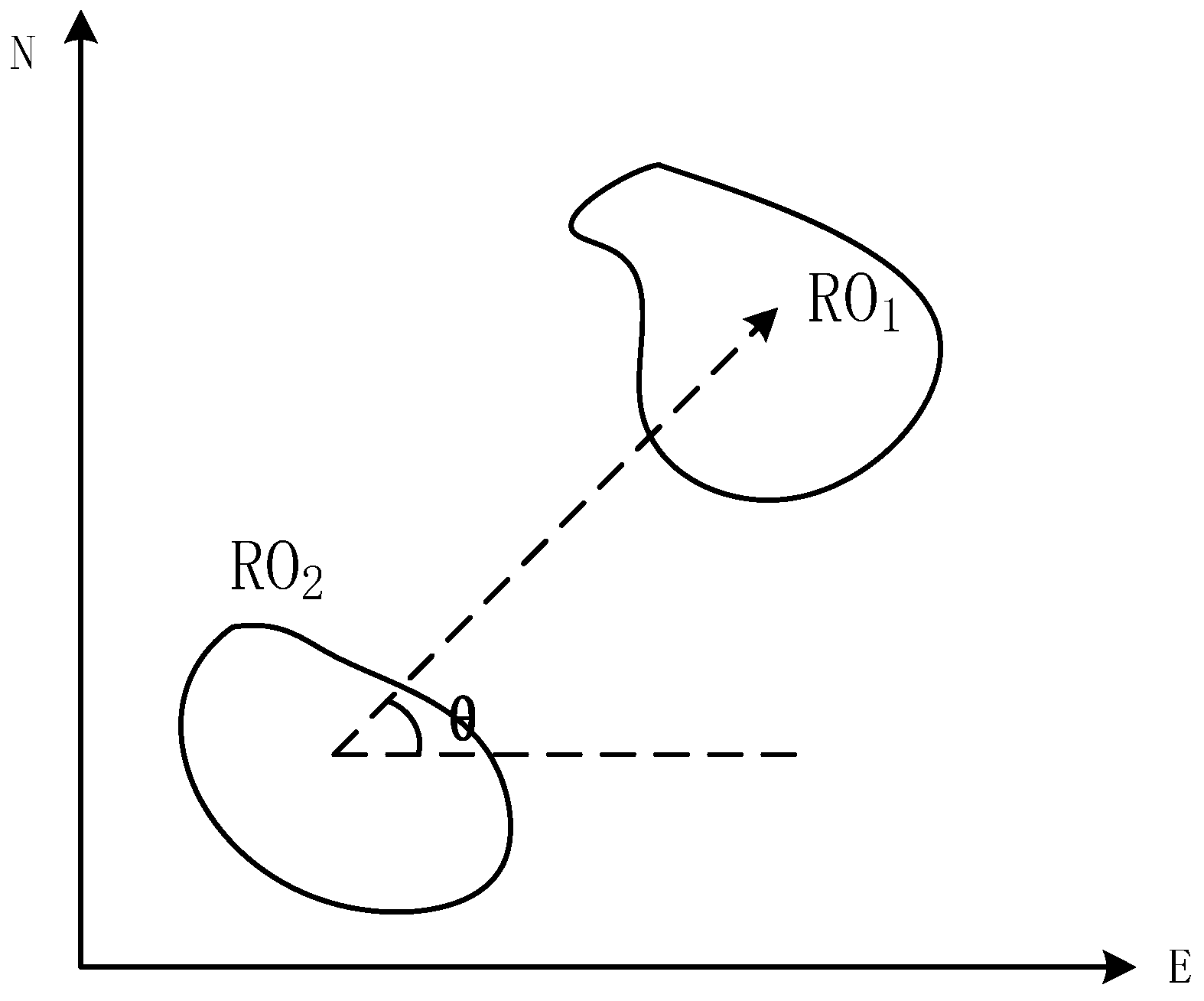


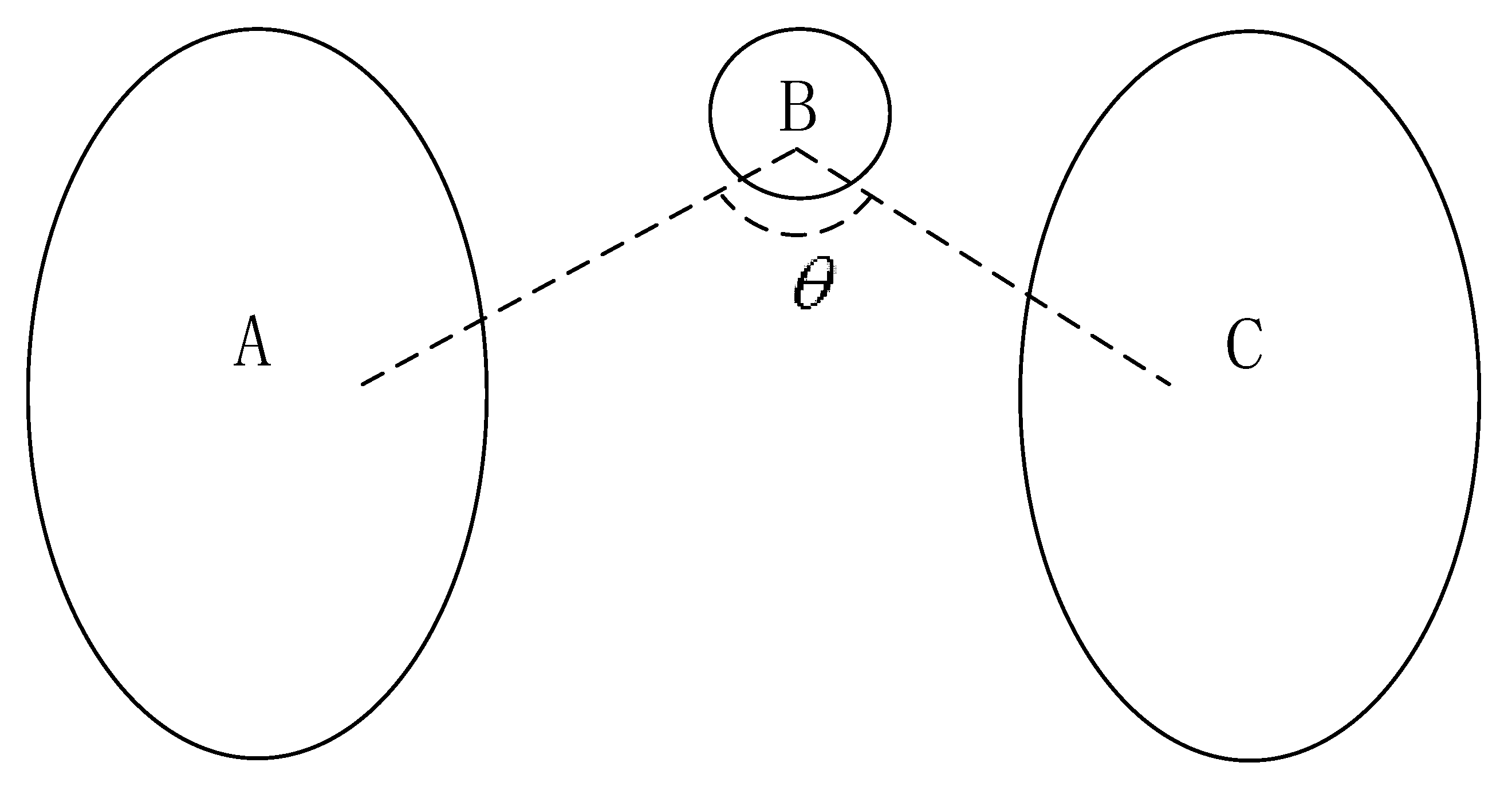

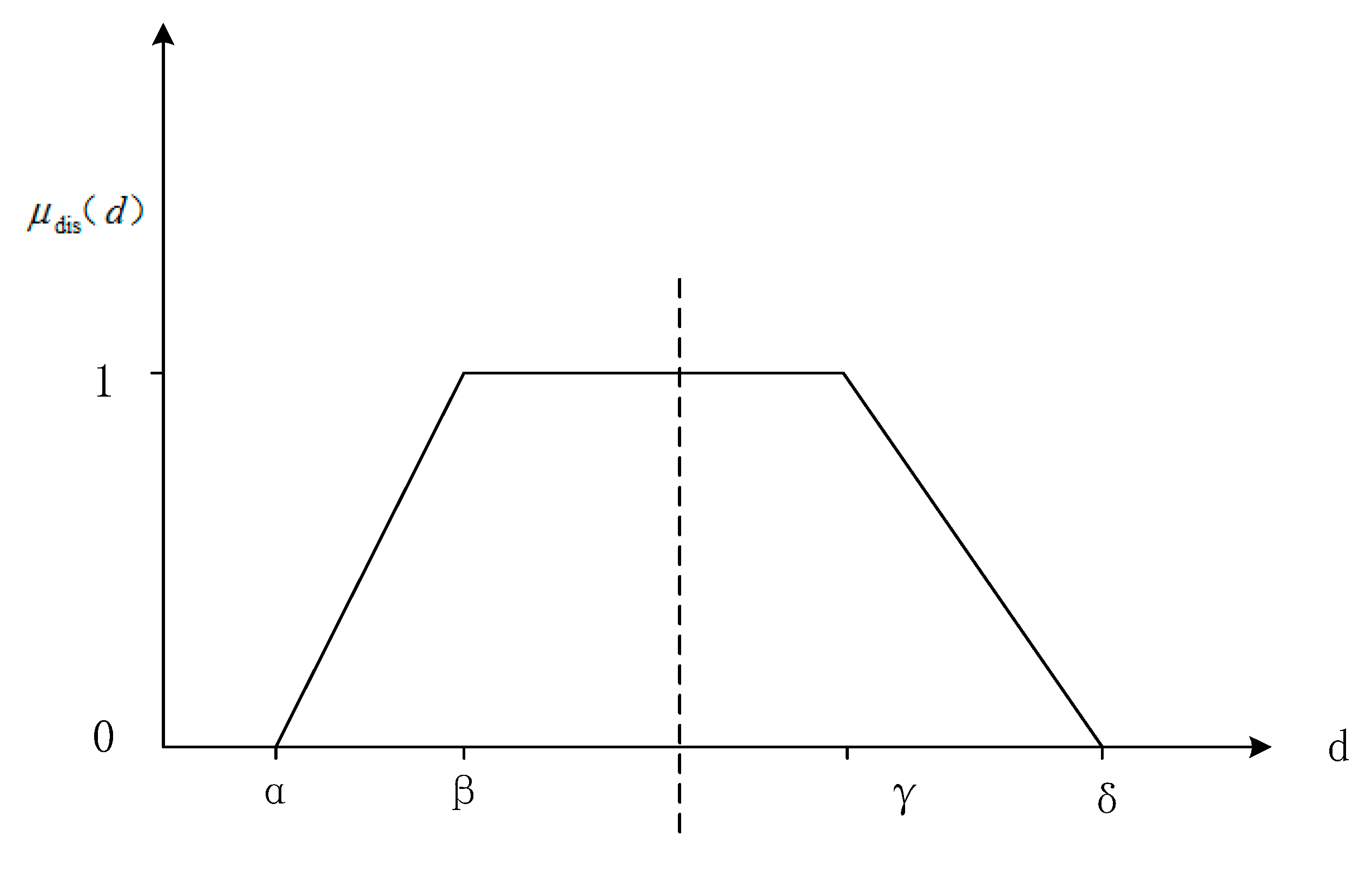
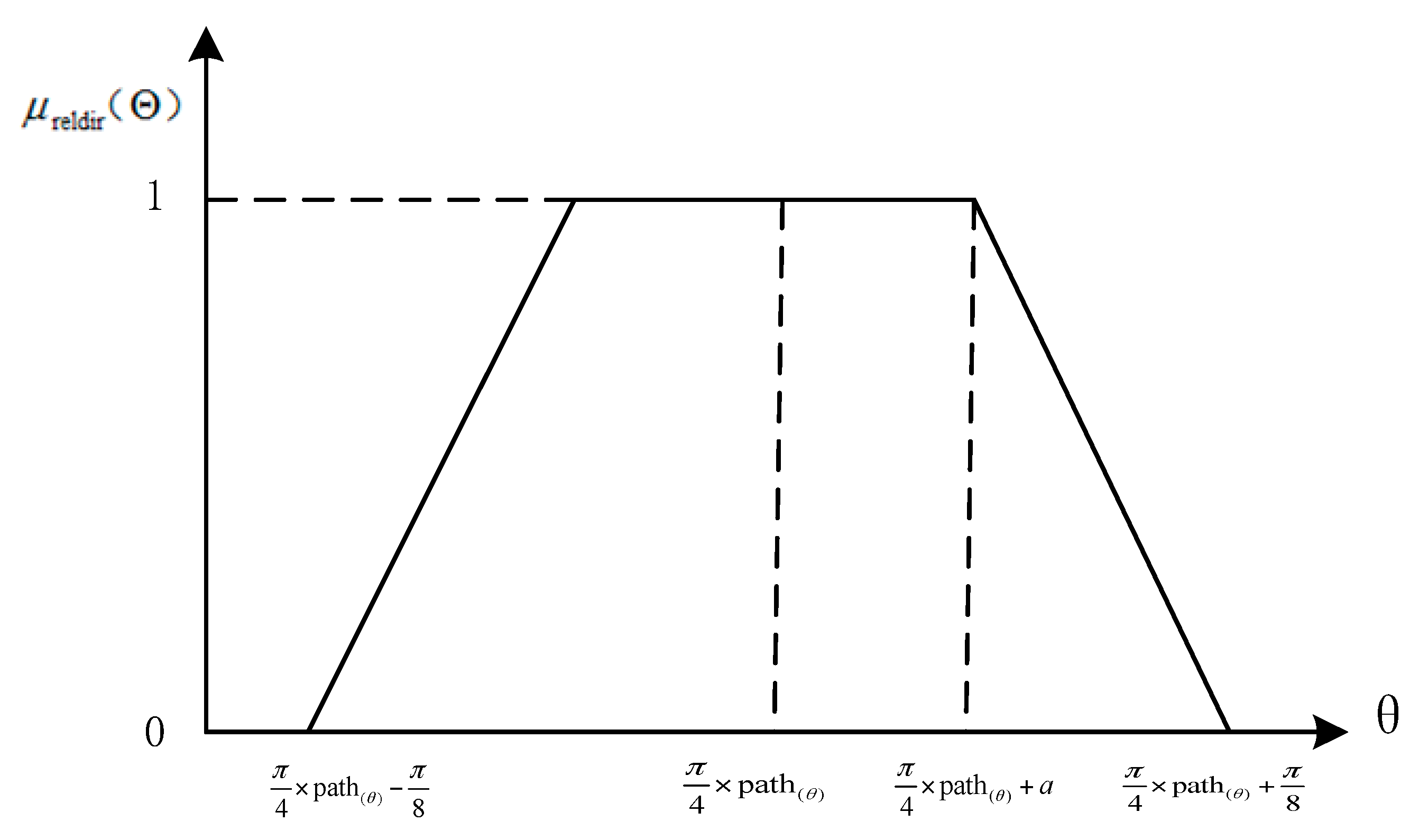
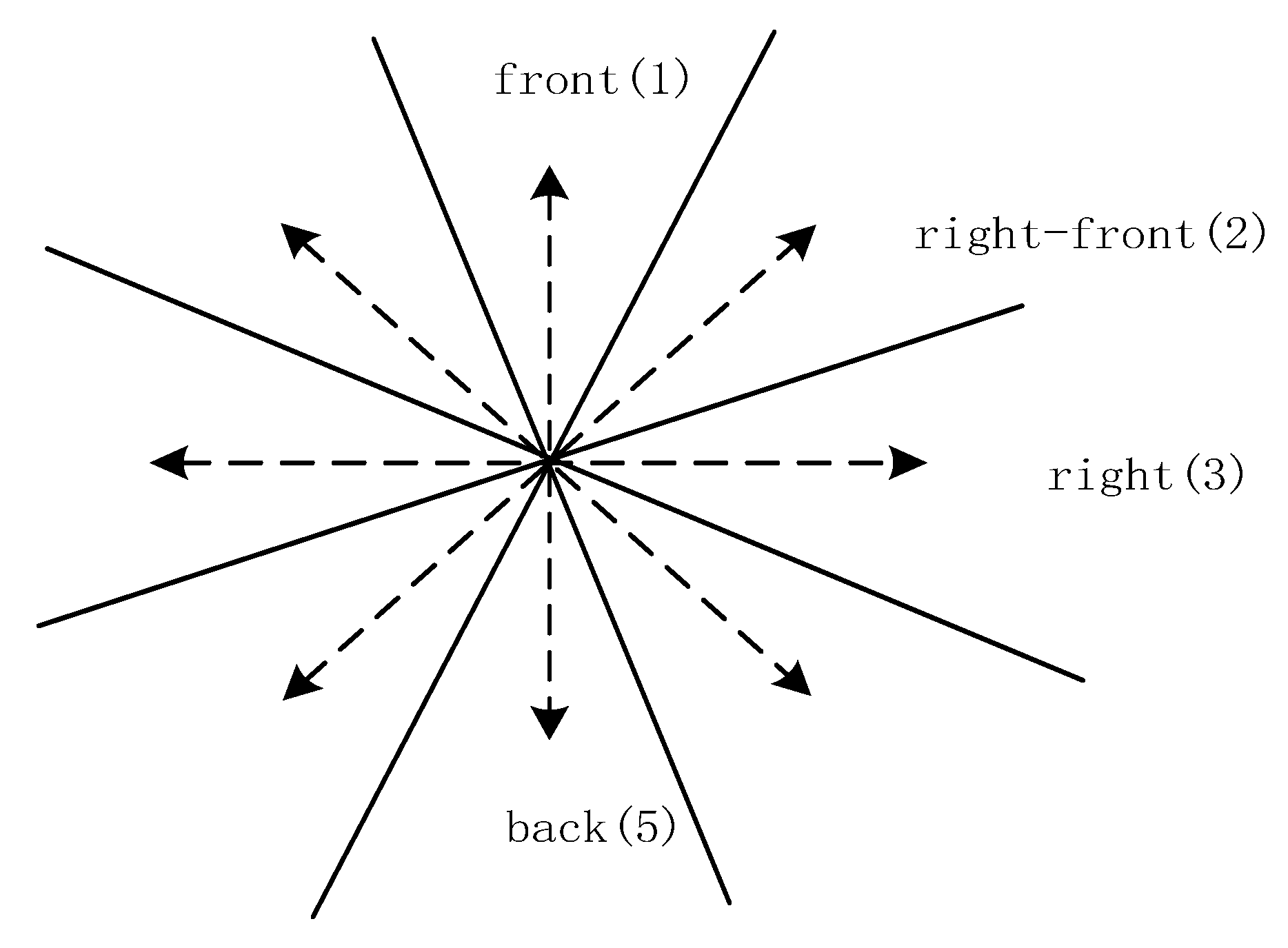


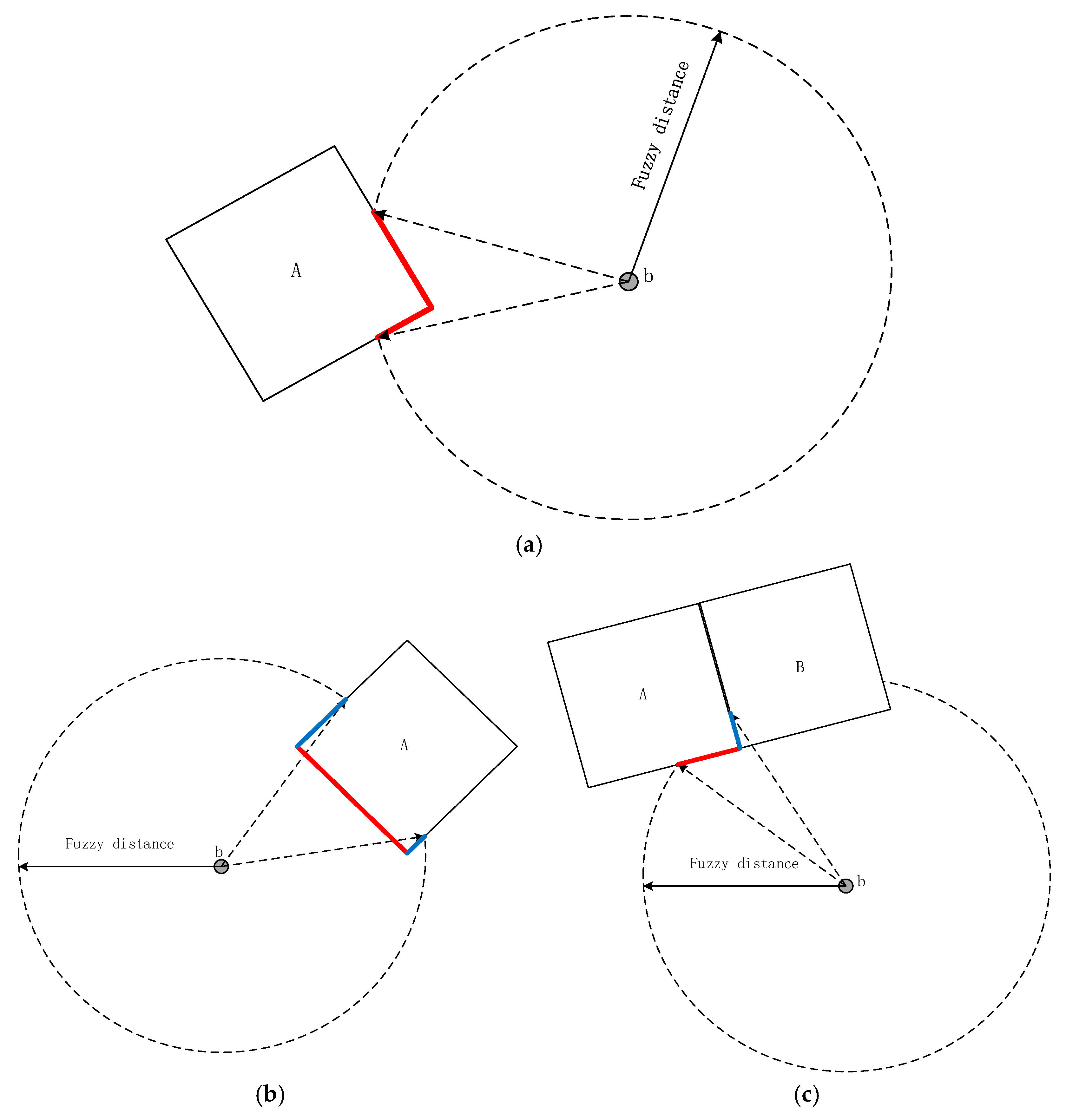

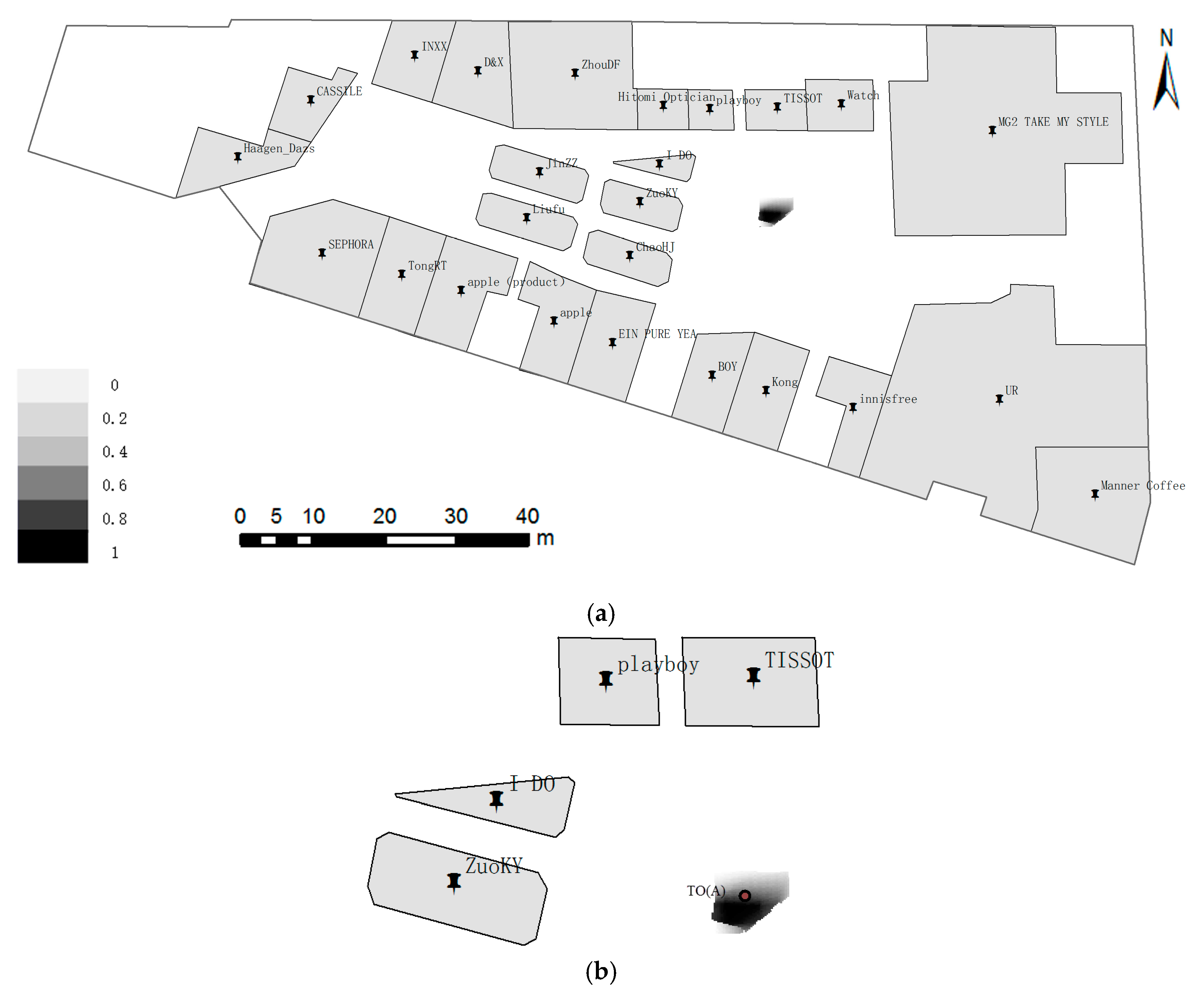

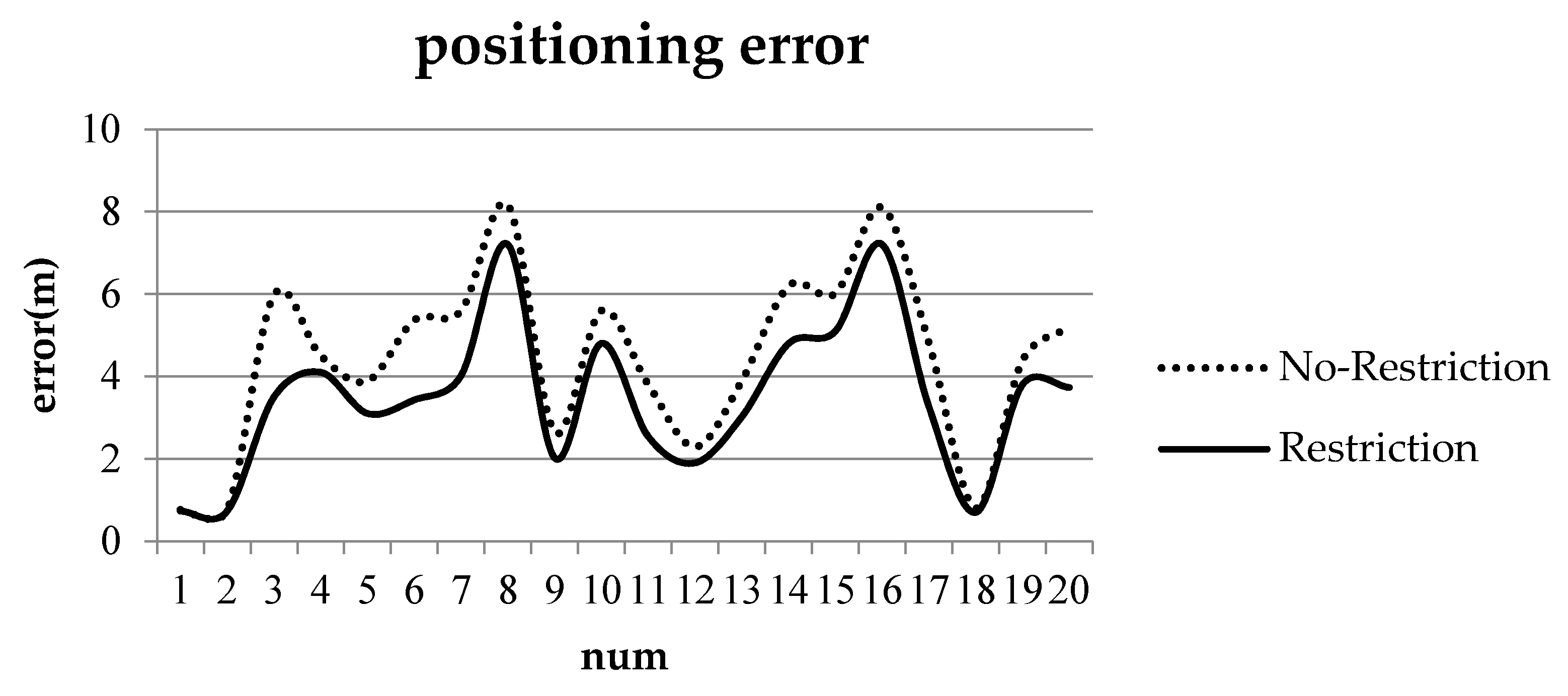
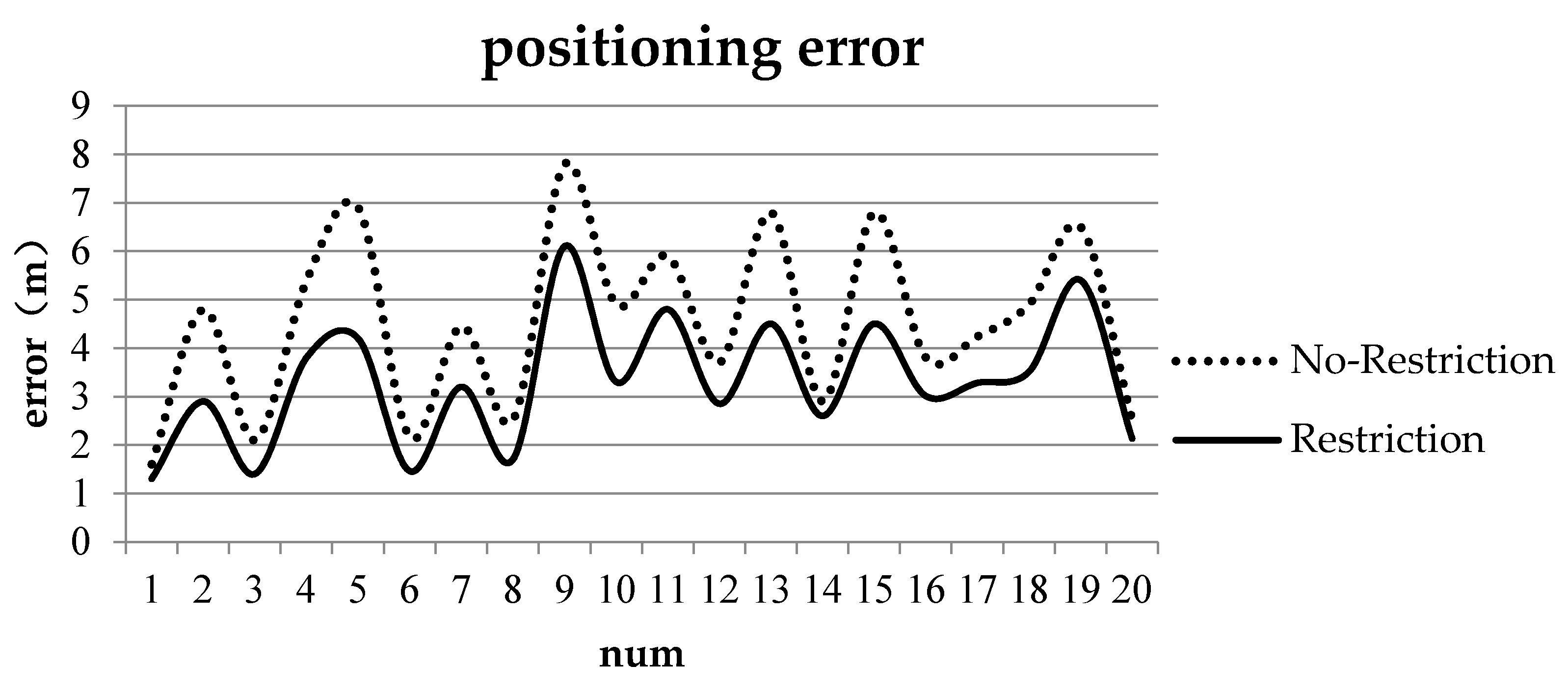
| TO | Num | RO1 | RO2 | ||||
|---|---|---|---|---|---|---|---|
| Name | Distance | Direction | Name | Distance | Direction | ||
| A | 1 | ZuoKY | 15 | front | TISSOT | 15 | right |
| 2 | ZuoKY | 15 | left | TISSOT | 15 | front | |
| 3 | ZuoKY | 10 | front | TISSOT | 15 | right | |
| 4 | I DO | 20 | front | ChaoHJ | 25 | left | |
| 5 | ZuoKY | 20 | left | TISSOT | 20 | front | |
| 6 | Playboy | 20 | right-front | ZuoKY | 15 | front | |
| 7 | I DO | 15 | front | ChaoHJ | 20 | left | |
| 8 | Playboy | 25 | front | ZuoKY | 20 | left | |
| 9 | I DO | 15 | left-front | TISSOT | 15 | front | |
| 10 | ZuoKY | 15 | front | TISSOT | 20 | right | |
| B | 11 | Watch | 15 | front | Playboy | 25 | right-front |
| 12 | Watch | 10 | front | Playboy | 20 | right-front | |
| 13 | Watch | 15 | right-front | Playboy | 20 | front | |
| 14 | Watch | 20 | front | Playboy | 30 | right-front | |
| 15 | Watch | 20 | front | ZuoKY | 30 | left | |
| 16 | Watch | 25 | front | ZuoKY | 30 | left | |
| 17 | Playboy | 30 | right-front | ZuoKY | 30 | front | |
| 18 | Playboy | 25 | right-front | ZuoKY | 25 | front | |
| 19 | ChaoHJ | 30 | right | I DO | 20 | front | |
| 20 | ChaoHJ | 40 | right-front | I DO | 30 | front | |
| TO | Num | RO1 | RO2 | RO3 | ||||||
|---|---|---|---|---|---|---|---|---|---|---|
| Name | Distance | Direction | Name | Distance | Direction | Name | Distance | Direction | ||
| A | 1 | ZuoKY | 15 | left | TISSOT | 15 | front | Hitomi Optician | 20 | left-front |
| 2 | ZuoKY | 10 | left | TISSOT | 15 | front | Hitomi Optician | 20 | left-front | |
| 3 | ZuoKY | 15 | front | TISSOT | 15 | left | Hitomi Optician | 25 | left-front | |
| 4 | ZuoKY | 20 | left | TISSOT | 25 | front | Hitomi Optician | 30 | left-front | |
| 5 | ZuoKY | 15 | left | TISSOT | 20 | front | I DO | 15 | left-front | |
| 6 | ZuoKY | 15 | front | TISSOT | 15 | left | I DO | 15 | left-front | |
| 7 | ZuoKY | 20 | left-front | TISSOT | 20 | right-front | I DO | 20 | front | |
| 8 | ZuoKY | 15 | left-front | TISSOT | 15 | right-front | Playboy | 20 | front | |
| 9 | ZuoKY | 20 | left-front | TISSOT | 20 | right-front | Playboy | 30 | front | |
| 10 | ZuoKY | 15 | left-front | TISSOT | 15 | right-front | Playboy | 25 | front | |
| B | 11 | I DO | 30 | front | ChaoHJ | 30 | left-front | TISSOT | 20 | right-front |
| 12 | I DO | 25 | front | ChaoHJ | 30 | left-front | TISSOT | 15 | right-front | |
| 13 | Watch | 20 | front | ZuoKY | 30 | left | Playboy | 30 | left-front | |
| 14 | Watch | 15 | right | ZuoKY | 25 | front | Playboy | 25 | left-front | |
| 15 | Watch | 20 | right-front | ZuoKY | 30 | left-front | Playboy | 30 | front | |
| 16 | Watch | 20 | left | Playboy | 30 | right-front | I DO | 30 | front | |
| 17 | Watch | 10 | front | ZuoKY | 25 | left | Playboy | 25 | left-front | |
| 18 | Watch | 15 | right-front | ZuoKY | 30 | left-front | Playboy | 30 | front | |
| 19 | I DO | 30 | right | ChaoHJ | 35 | left | TISSOT | 20 | front | |
| 20 | Watch | 15 | left | ChaoHJ | 25 | right-front | I DO | 25 | front | |
© 2017 by the authors. Licensee MDPI, Basel, Switzerland. This article is an open access article distributed under the terms and conditions of the Creative Commons Attribution (CC BY) license (http://creativecommons.org/licenses/by/4.0/).
Share and Cite
Wang, Y.; Fan, H.; Chen, R. Indoors Locality Positioning Using Cognitive Distances and Directions. Sensors 2017, 17, 2828. https://doi.org/10.3390/s17122828
Wang Y, Fan H, Chen R. Indoors Locality Positioning Using Cognitive Distances and Directions. Sensors. 2017; 17(12):2828. https://doi.org/10.3390/s17122828
Chicago/Turabian StyleWang, Yankun, Hong Fan, and Ruizhi Chen. 2017. "Indoors Locality Positioning Using Cognitive Distances and Directions" Sensors 17, no. 12: 2828. https://doi.org/10.3390/s17122828





